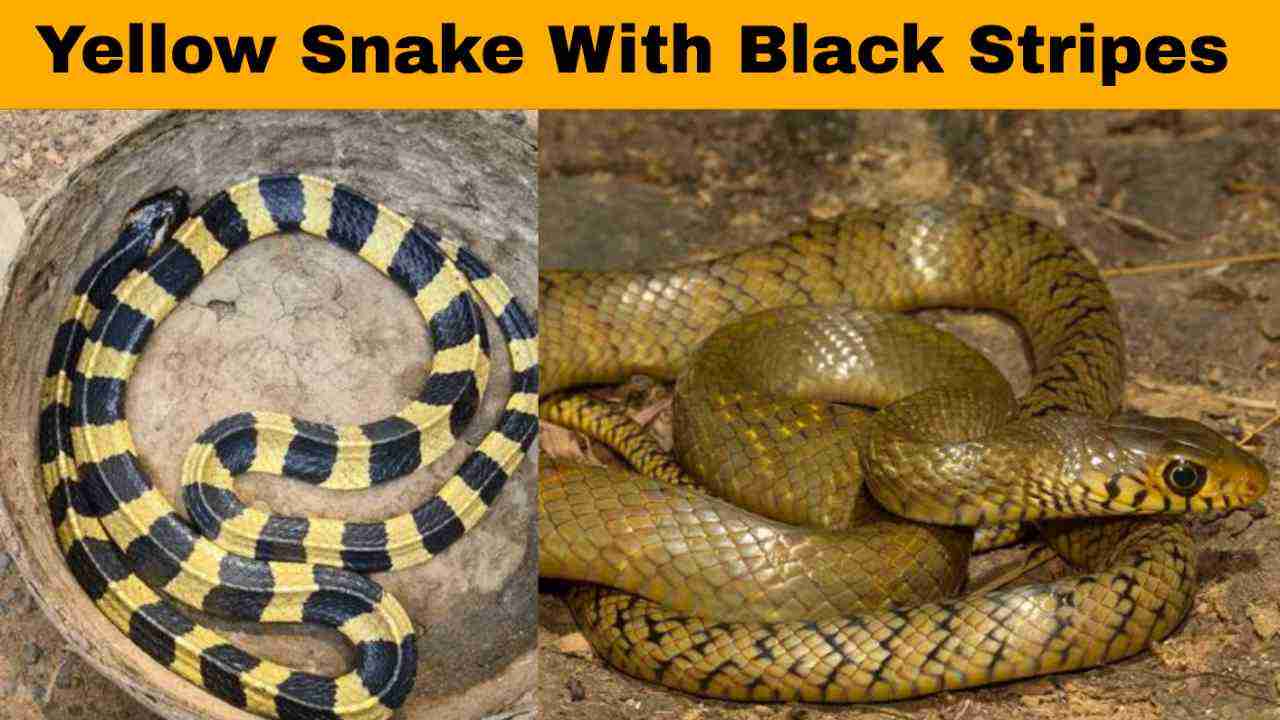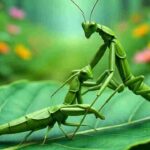Yellow snake with black stripes: Have you spotted something and are trying to identify it? If something is unknown to you and you’re trying to identify what it is, you must keep in mind the features you observed in your first encounter, especially regarding its physical appearance. Physical appearance means the color, body shape, and any special patterns or spots, such as those found on a black and yellow (stips, lines, dots, spots, scattered mixed colour). These are common features to remember when spotting any snake around you. Here, we are specifically talking about black and yellow striped snakes. In general terms, we can describe it as a yellow snake with black stripes or even a snake with yellow and black stripes.
There are around 3,000 species of snakes found all over the world, except in Antarctica and a few special places. Almost every region is a habitat for these reptiles. Snakes can vary in color, shape, and size, and they are classified into two main categories: venomous and non-venomous. The venomous category has poison glands in their mouths capable of killing any living being, even a young elephant. That’s why we can say venomous snakes are capable of taking down any enemy. On the other hand, non-venomous snakes have venom glands, but the effect of their venom is mild. While small species may die from non-venomous bites, larger species like humans cannot die from them, except in rare cases. Non-venomous bites may cause mild effects, such as swollen skin or headaches.
How to identify a yellow snake with black stripes?
There are a few things you should keep in mind. By identifying these patterns and the data provided here, you can match what you’ve seen to the details given. The common name may vary in different places, but the scientific name remains the same all over the world for the same species. If the snake you saw matches the picture but has a different local name, this could be due to geographical differences. However, the scientific name is universal.
Keep in mind the following things:
- Color – What was the color of the snake you saw?
- Size – Was the snake smaller or larger?
- Shape – Was the shape cylindrical or did it have any flat surfaces?
- Special pattern – Most species do not have a uniform color. They often have different patterns on their bodies, such as circles, spots, scattered stripes, lines, or small patches of different colors.
Yellow Snakes With Black Stripes
Here the snake with yellow and black color –
Banded krait

| Scientific Name | Bungarus fasciatus |
| Color | Black and yellow crossbands |
| Found in | Indian Subcontinent, Southeast Asia, Southern China |
| Venom | Venomous, neurotoxic venom |
| Size | Up to 2.25 meters (7 ft 5 in) |
The banded krait (Bungarus fasciatus) is easily identifiable by its distinct black and yellow crossbands that encircle its body. The banded krait is also known as the krait. It has a broad, depressed head with black eyes and yellow markings on its lips, chin, and throat. The snake’s body is cylindrical with a blunt tail and prominent vertebral scales creating a noticeable ridge down its back. The banded krait can grow up to 2.25 meters in length, making it the longest krait species. Its venomous bite contains neurotoxins, which are dangerous to humans, though the snake is generally timid. Bungarus fasciatus is found in India, Nepal, Bangladesh, Myanmar, Cambodia, Thailand, Laos, Vietnam, Southern China, Malaysia, Indonesia, and Singapore.
Key features: black and yellow bands, broad head, blunt tail, neurotoxic venom.
Eastern Ratsnake

| Scientific Name | Pantherophis alleghaniensis |
| Color | Variable: Black, Yellow, Gray, Orange, Tan |
| Found in | United States (Florida, Panhandle, Key Largo) |
| Venomous or Nonvenomous | Nonvenomous |
| Size | Up to 6 feet (1.8 meters) |
The Eastern Ratsnake (Pantherophis alleghaniensis) is a non-venomous species found in the United States. It is commonly known as the Black Ratsnake, Chicken Snake, Pilot Black Snake, Yellow Ratsnake, and Gray Ratsnake. Its coloration varies: juveniles are gray with dark blotches, while adults in Florida may be yellow, orange, tan, or gray with four dark longitudinal stripes, sometimes retaining juvenile blotches. It inhabits pinelands, hardwood hammocks, swamps, marshes, and suburban areas where development overlaps with its habitat. The species is commonly found in Florida’s Panhandle and extends throughout the Florida peninsula to Key Largo.
Key features: variable coloration, four dark stripes in adults, non-venomous.
Boiga wallachi

Credit -The Reptile Database
| Scientific Name | Boiga wallachi |
| Common Name | Nicobar Cat Snake |
| Venomous or Nonvenomous | Mildly Venomous |
| Color | Yellowish-brown with black or dark brown uneven spots; bright yellow underside with small black spots |
| Found in | Southern Nicobar Group of Islands (Great Nicobar, Little Nicobar, Pilo Milo Islands) |
| Size | 73.5–105.0 cm snout-to-vent length, total body length up to 131 cm (52 in) |
Boiga wallachi, commonly known as the Nicobar Cat Snake, is a mildly venomous snake endemic to the Southern Nicobar Islands. It is yellowish-brown with black or dark brown uneven spots on the back and a bright yellow underside with small black spots. The head is marked with blackish or brown shields infused with dull yellow, and the lip scales are yellow. Juveniles are a uniform yellowish-brown. This snake is found near fresh-water bodies in forested areas, often seen coiled on rocks or small branches. It measures between 73.5–105 cm snout-to-vent length, with a total length of up to 131 cm.
Key features – The Boiga wallachi (Nicobar Cat Snake) is a mildly venomous, yellowish-brown snake with black spots, a bright yellow underside, and is endemic to the Southern Nicobar Islands, reaching a total length of up to 131 cm.
Yellow Viper

| Scientific Name | Bothriechis schlegelii |
| Common Names | Eyelash viper, Schlegel’s viper, Eyelash palm-pitviper, Eyelash snake, Horned palm viper |
| Color | Red, Yellow, Brown, Green, Pink, and various combinations |
| Venomous or Nonvenomous | Venomous |
| Size | 55–82 cm (22–32 in), females can grow longer than males |
| Found In | Southern Mexico, Central America, Colombia, Ecuador, and western Venezuela |
| Special Features | Eyelash-like scales, highly variable in color, small and agile |
The Yellow Viper (Bothriechis schlegelii), also known as the highland eyelash-pitviper, is a venomous pit viper species found in Latin America, ranging from Mexico to Colombia and Venezuela. It exhibits a wide variety of colors, including red, yellow, brown, green, and even pink. This small pit viper typically measures 55–82 cm in length, with females being larger than males. It is commonly referred to by several names, including eyelash viper, Schlegel’s viper, and in Spanish, bocaracá or oropel for its golden morph.
Key features – The Bothriechis schlegelii (Yellow Viper) is a venomous pit viper found in Latin America, notable for its eyelash-like scales, wide range of colors (red, yellow, brown, green, pink), and small size, with adults measuring 55–82 cm.
Yellow tree python

| Scientific Name | Morelia viridis |
| Color | Hatchlings are lemon-yellow with stripes/spots; adults change to green, yellow, or red |
| Found In | New Guinea, some islands in Indonesia, and Cape York Peninsula, Australia |
| Venomous/Non-Venomous | Non-venomous |
| Size | Reaches up to 2 meters (6.6 feet) in length, 1.6 kg (3.5 lbs) in weight |
The Yellow Tree Python (Morelia viridis) is a non-venomous snake that can grow up to 5–6 feet in length. Hatchlings are lemon-yellow with broken stripes and spots of purple and brown, or sometimes golden or orange-red. For yellow individuals at Iron Range National Park in Australia, the color changes over 5–10 days as they grow to around 58–60 cm long. Adults can reach up to 2 meters (6.6 ft) in length and weigh around 1.6 kg (3.5 lb), with females generally being larger. They are found in New Guinea, some Indonesian islands, and Cape York Peninsula in Australia.
Key features – The Yellow Tree Python is a non-venomous snake, reaching up to 2 meters in length, with lemon-yellow hatchlings and a habitat in New Guinea, Indonesia, and northern Australia.
Mangorova Snake

| Scientific Name | Boiga dendrophila |
| Common Name | Mangrove Snake, Gold-ringed Cat Snake |
| Color | Black with yellow or gold rings |
| Found in | Southeast Asia, including Cambodia, Indonesia, Brunei, Malaysia, Myanmar, Philippines, Singapore, Thailand, Vietnam |
| Venomous or Non-venomous | Mildly venomous (rear-fanged) |
| Size | 8–9 feet (2.4–2.7 meters) |
| Habitat | Lowland rainforests, occasionally found in mangrove swamps |
The Boiga dendrophila, commonly known as the mangrove snake or gold-ringed cat snake, is a mildly venomous, rear-fanged snake belonging to the family Colubridae. Endemic to Southeast Asia, it is one of the largest cat snakes, reaching lengths of 8–9 feet (2.4–2.7 m). Despite moderate envenomations causing swelling, no fatalities have been reported. It is found across Cambodia, Indonesia, Malaysia, Myanmar, the Philippines, and more. Although its name suggests an association with mangrove swamps, it primarily inhabits lowland rainforests.
Key features – Boiga dendrophila is a mildly venomous cat snake, growing up to 8-9 feet, and found in Southeast Asia’s lowland rainforests.
Morelia spilota cheynei

| Scientific Name | Morelia spilota cheynei |
| Common Name | Jungle Carpet Python |
| Color | Black and yellow patterns |
| Size | 5–7 feet, females larger than males |
| Found In | Queensland, Australia |
| Venomous or Non-venomous | Non-venomous |
Morelia spilota cheynei, commonly known as the Jungle Carpet Python, is a python subspecies found in the rainforests of Queensland, Australia. It has a striking black and yellow color pattern, which helps it blend into the forest environment. This species is medium-sized, with adults typically measuring 5–7 feet in length, although females can grow over 8.5 feet. The vibrant black and yellow coloration makes it a popular snake for collections, especially lineages like the German Bloodline. Females are larger than males, as in most snake species.
Key features – The Jungle Carpet Python has vibrant black and yellow patterns, grows 5–7 feet, is found in Queensland rainforests, with females larger than males.
North-eastern Vine Snake

| Scientific Name | Ahaetulla flavescens |
| Common Name | Yellow Vine Snake |
| Color | Green, cream-brown, yellow, grey with black and white patterns |
| Found in | Nepal, northeast Indian subcontinent, Myanmar |
| Venomous/Nonvenomous | Mildly venomous |
| Size | Up to 197 cm (6.5 ft) |
The yellow vine snake (Ahaetulla flavescens) is a mildly venomous species known for its thin and elongated body, reaching lengths of up to 197 cm. This snake displays a variety of colors, including green, cream-brown, yellow, and grey, often featuring obliquely arranged black and white interscale patterns that are most visible when the snake is provoked. It is widely distributed across Nepal and the northeast region of the Indian subcontinent, extending into Myanmar.
Key features – The yellow vine snake (Ahaetulla flavescens) is a mildly venomous snake, reaching up to 197 cm in length, displaying colors like green, cream-brown, yellow, and grey, and is widely distributed from Nepal to the northeast region of the Indian subcontinent and Myanmar.






